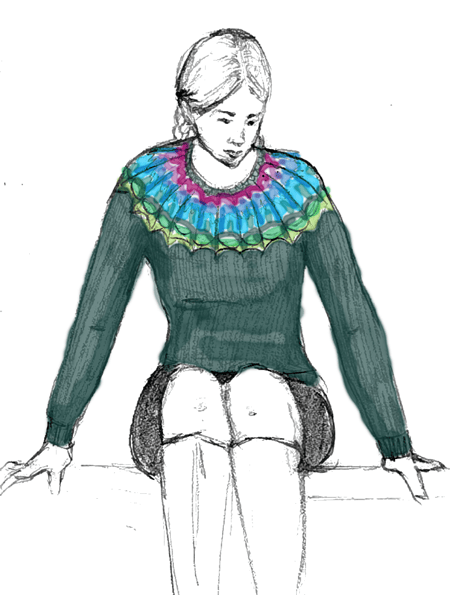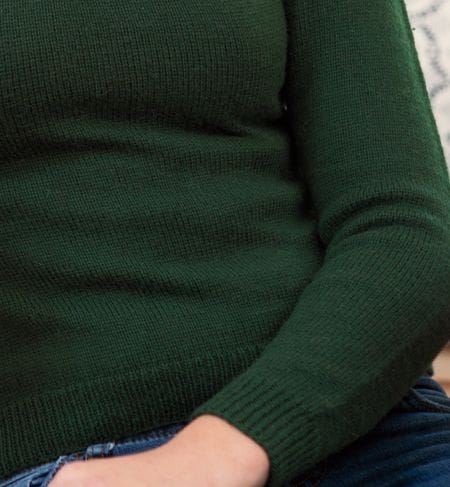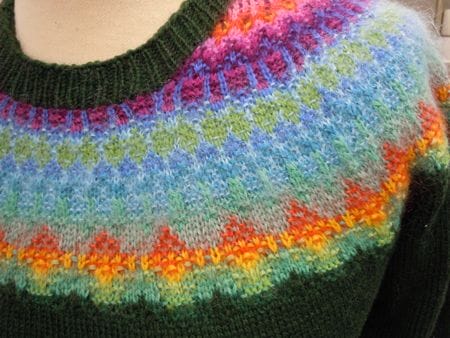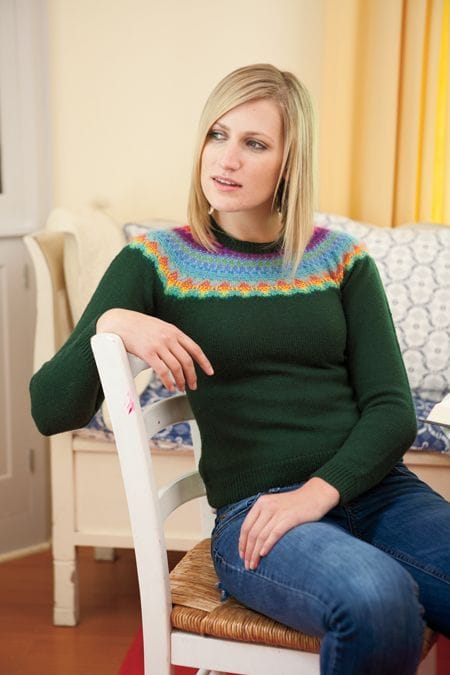Bohus sweaters are known for their subtle gradients of color and the fuzzy halo that gives them an almost ethereal glow. The tradition of Bohus sweater knitting is a recent and colorful one, inspired by many other European knitting styles and the fashions of the mid 20th century.
The most recognizeable Bohus item is the yoked sweater. Though the typical elements of a Bohus-style sweater can be applied to lots of items like gloves and hats, a colorful stranded yoke really shows off the techniques used. Careful planning of increases, multiple colors in each row, knit and purl stitches and slipped stitches create a texture unique to Bohus knitting. This texture can make even the simplest motif, like stripes or dots, look exotic and unexpected. When I began thinking about Tuva, I wanted color to become the real focus, and let the stitches help to show them off. I didn’t want this to be subtle – and immediately jumped for a vivid rainbow.
With so many elements to balance, designing a Bohus-style yoked sweater presents some interesting challenges. Firstly, most are knit top-down, with a straight cast-on and a funnel-like neck shape. While this does allow you to jump right into colorwork, it makes it more difficult to shape the neckline if you wanted. When designing Tuva, I decided that a crew neck would be more suitable for modern styling. Rather than simply casting on more stitches to make a wider neck, having the actual neckline higher in the back and lower in the front makes it more comfortable. The easiest way to work that shaping in a colorwork yoke is from the bottom up, so I made the decision to save the best till last and knit the body and sleeves first.
The sleeves and body are both worked in plain Stockinette stitch in the round, with a simple ribbed trim. Because of this simplicity, it’s easy to add length by inserting extra rounds between increase rounds or before and after increase sections. And once the sleeves and body are knit, joined into one piece and continued a short way, the boring bit is over and the brilliant colorwork begins!

The first step in designing any colorwork pattern is determining a repeat. Because the yokes are all different stitch counts and different depths, this can become a challenge. Going with a low stitch count repeat, in this case 12 stitches, allows enough stitches to make an interesting pattern but few enough that each repeat is small and can fit easily onto differently sized yokes. Then comes the difficult part – determining decrease rate, neckline size and shaping, and how to get all the colors and the whole pattern onto each size sweater. I won’t bore you with the math, but let’s just say I borrowed some really great ideas from Icelandic sweaters in designing a too-long repeat and then omitting certain rounds for each size. This means that in each size, you’d run through the whole pattern, but larger sizes just have more pattern to do. (In fact, if you look at the pattern for Baldrun, the same line-omission sizing occurs there, too.) We knit the smallest size of Tuva, so all the other sizes just have more yoke to knit, but the same patterning.
Designing a yoke in that way also allowed me to keep repeat stitch counts the same in the same place in all sizes – which sounds unimportant until you begin shaping the neckline. Each size binds off a number of stitches at the center neck, and then slowly decreases away the remaining neckline, until a nice crew neck shape emerges out of the colorwork. A smiple ribbed collar finishes off the sweater – and then all that stands between you and wearing it is the finishing work. (and if you want to cut to the chase and wear it as soon as possible, check out my video on braiding in the ends on colorwork!)
Tuva is the result of a lot of planning, math, rainbows, and the inspiration of a knitting tradition that was born of necessity and has since become a symbol of knitting prowess. But I’ll let you in on a little secret – Bohus-style knitting is so fun and engaging, you won’t even realize that it’s supposed to be difficult!



